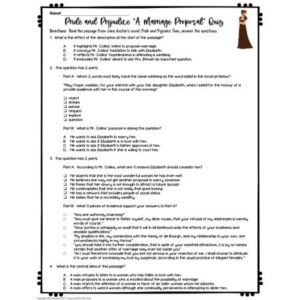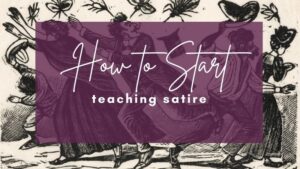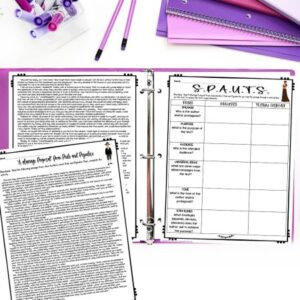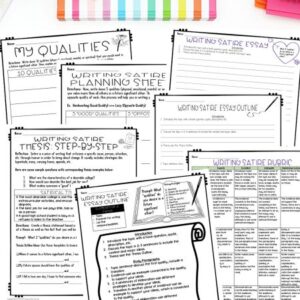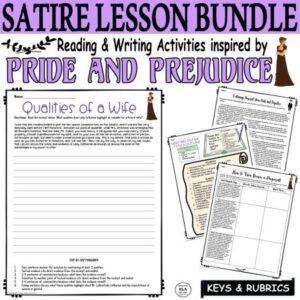Like many lovers of British Literature, I fell in love with Jane Austen’s Pride and Prejudice in high school! Who doesn’t love the tangled conflict between Darcy and Elizabeth? Who doesn’t enjoy the descriptions of the manners, beauty, and simplicity of the time period? So, the question I, as a new teacher needed to answer was the following: How can I teach Pride and Prejudice Activities and Lessons in a way my students would actually enjoy?
I know there are so many other things to worry about as a beginning teacher; however, I came to teaching, in part, due to my love of the English language. And my obsession with Austen only intensified with exposure to her other great works like Persuasion, Emma, and Sense and Sensibility.
So if you want to use Pride and Prejudice activities WITHOUT having to read the WHOLE book, keep reading for pain-free and inspiring ideas!
Need help with Test Prep? Check out this FREE Pack of 3 Test Prep Activities to help students achieve success on standardized tests!

7 Pain-Free Pride and Prejudice Activities
1. Read excerpts, scenes, or chapters that students will find intriguing!
My absolute favorite scenes from Pride and Prejudice include the following:
- Introduction to the Bennet Family in Chapter 1.
- The party that establishes Bingley and Darcy as the two leading men.
- Mr. Collins’ proposal of marriage to Elizabeth.
- Mr. Darcy’s FIRST proposal of marriage to Elizabeth.
- Lady Catherine’s appeal to Elizabeth at the story’s end.
- And I could just keep going…
While I personally could not imagine reading only excerpts of Austen’s classics, I don’t know that many average 12th-grade classes could handle reading the entire novel simply because it would require reading both inside and outside of class. Time is of the essence.
Instead, why not read 2-4 scenes while focusing on reading comprehension standards in your Pride and Prejudice activities?
My favorite 2 scenes are the proposals from Mr. Collins and Mr. Darcy.
Here are several questions you might ask for each passage:
- What is the purpose of the passage?
- What does the passage reveal about the values of people in this period?
- How does the diction contribute to the characterization of Elizabeth, Mr. Collins, and Mr. Darcy?
Now, if you want a more comprehensive quiz for both passages, check out this resource that includes 50 test prep questions and answers!
2. Write a 1-sentence summary for chunks or paragraphs instead of a whole summary.
You may want to read the excerpts, passages, or chapters with your students, so they can fully understand what is going on. Austen sometimes includes so much within a single sentence that guiding students through her novel is key.
Why not work on summarizing while reading this classic romance?
Check out this example from CHUNK #4 of Mr. Collins’ proposal:
It was absolutely necessary to interrupt him now.
“You are too hasty, sir,” she cried. “You forget that I have made no answer. Let me do it without further loss of time. Accept my thanks for the compliment you are paying me. I am very sensible of the honour of your proposals, but it is impossible for me to do otherwise than to decline them.”
“I am not now to learn,” replied Mr. Collins, with a formal wave of the hand, “that it is usual with young ladies to reject the addresses of the man whom they secretly mean to accept, when he first applies for their favour; and that sometimes the refusal is repeated a second, or even a third time. I am therefore by no means discouraged by what you have just said, and shall hope to lead you to the altar ere long.”
“Upon my word, sir,” cried Elizabeth, “your hope is a rather extraordinary one after my declaration. I do assure you that I am not one of those young ladies (if such young ladies there are) who are so daring as to risk their happiness on the chance of being asked a second time. I am perfectly serious in my refusal. You could not make me happy, and I am convinced that I am the last woman in the world who could make you so. Nay, were your friend Lady Catherine to know me, I am persuaded she would find me in every respect ill qualified for the situation.”
CHUNK 4:
Ex. Elizabeth interrupts Mr. Collins’ proposal in order to reject him; however, he is convinced that she is only refusing him because she is playing hard to get.
Get Pride and Prejudice activities that include 1-sentence summaries–> Pride and Prejudice Activities BUNDLE
3. Analyze the text as satire.
If you have not introduced satire yet, incorporating Pride and Prejudice activities may provide the perfect opportunity.
Satire is typically defined as a text that criticizes, usually through imitation, irony, hyperbole, and sarcasm, in order to bring about some sort of change.
The way Mr. Collins proposes offers the perfect fodder for criticism of the courtship, engagement, and marriage process in the early 1800s. His reasons for choosing Elizabeth reveal the absurdity of the time. Her response, however, displays the empathy and softness of a typical genteel lady of the era.
“You are too hasty, sir,” she cried. “You forget that I have made no answer. Let me do it without further loss of time. Accept my thanks for the compliment you are paying me. I am very sensible of the honour of your proposals, but it is impossible for me to do otherwise than to decline them.”
His responses will make students laugh as they will quickly see he epitomizes the phrase “not being able to take no for an answer.” If you want a bit of help breaking down this proposal with Pride and Prejudice activities for high school students, click here!
Want more help teaching satire? Click below!
4. Conduct a Socratic Seminar based on varied passages.
Choose a couple of excerpts to help students center on as a part of their Pride and Prejudice activities. As students read with you, model how to annotate, underline important textual evidence, and create questions relating to various themes, characterization, author’s purpose, universal ideas, etc.
When I use the Socratic Seminar Method, I let students lead the discussion; however, there are rules to the process that allow for optimal participation:
- Use small groups that change in and out of the discussion, so specific students cannot dominate the seminar.
- Change up the passages after about 5-10 minutes, so there is a lot to talk about.
- After you (students) have discussed or asked a question, encourage others to do the same.
- Spend time delving into the question or topic before moving on, as one person responding is not enough.
- While watching others discuss, write down what certain students do well, what they said, and what was interesting for later shout-outs!
Ultimately, we want students to discuss, but you cannot force everyone to meet the speaking and listening standards; you only have to provide the opportunity.

5. View scenes of various versions for a film analysis.
I love it when students can learn about film analysis, so Pride and Prejudice activities that incorporate viewing and examining films are my cup of tea!
You can always watch certain scenes for comprehension purposes, but I like to teach about film techniques and how they contribute to the mood, characterization, and theme!
You could even compare and contrast different versions of the book as a part of your Pride and Prejudice activities repertoire.
6. Examine excerpts rhetorically.
Before focusing on various appeals, break down the important elements of a specific excerpt like Mr. Collins’ Proposal by using SPAUTS.
S-Speaker: Who is the author and/or protagonist?
P-Purpose: What is the purpose of the text?
A-Audience: Who is the intended audience?
U-Universal Ideas: What are some major ideas/messages from the text?
T-Tone: What is the tone of the author and/or protagonist?
S-Strategies: What strategies (appeals, devices, elements) does the author use to achieve the purpose?
It can be difficult for students to separate what Mr. Collins says from what Austen intends, so feel free to assist students as they respond in various Pride and Prejudice activities!
7. Guide students in writing their own satire.
Most of your students will never have written a satire in their lives, BUT most have seen satire without realizing it. From The Simpsons to The Daily Show with Jon Stewart as well as advertisements and short videos, satire is hiding, or really in plain view, everywhere in our culture.
In order to start working on Pride and Prejudice activities involving satire, I like to have students examine themselves. What good qualities do they like in themselves? What qualities do they like in a possible or future significant other?
After answering these questions, have students use antonyms to write about their 3 least favorite qualities in a satire. I promise; they will LOVE this writing activity!
Ensure you use a thesis template, outline, and example to help your students as they work on Pride and Prejudice activities. When students have finished, allow for time to share in pairs, small groups, or with the whole class 🙂
Pride and Prejudice Activities Resource
Do you want to teach Jane Austen’s Pride and Prejudice but you don’t have weeks to read the book? This Satire Lesson Unit BUNDLE will help make teaching satire FUN and EASY! Students will read, analyze, and dissect Mr. Collins’ Marriage Proposal with a focus on ultimately writing their own satirical essays by answering the question:
What “qualities” do you desire in a future significant other?
You will go step-by-step through the process of planning, creating a thesis, and writing a piece of satire! There are also TWO test prep quizzes for BOTH Mr. Collins’ Proposal AND Mrs. Darcy’s First Proposal! Have fun with this NO PREP PRIDE AND PREJUDICE ACTIVITIES BUNDLE!!!
Need more resources like the Pride and Prejudice Activities above? Check out my store Kristin Menke-Integrated ELA Test Prep!


